






There have been a few small showers over the period in some parts of the Conservation area. The fodder is increasingly becoming scarce with most water pans running dry. The Tsavo Veterinary Unit was able to the attend 9 cases that were reported during July. Arrow and snare wounds were particularly prevalent during the month, and the Unit attended to 2 elephants with arrow injuries as well as a snared elephant, zebra and waterbuck. All, except one elephant as the arrow was poisoned, were successfully treated. A zebra sadly died on the Nairobi Mombasa Highway when it was knocked down by a vehicle, two other elephants also died from natural causes which could be contributed to the prevailing drought and a cheetah was treated for recurring mange after it continued to lose body condition.
The Tsavo Mobile Veterinary Unit would like to thank all the stakeholders who assisted in reporting and monitoring wild animals that required help. Thanks to Vier Pfoten through SWT for their continuous facilitation of the unit. Thanks to KWS management for the technical support given to the unit.
1 Jul 22 Elephant Taita Ranches
Jul 22 Zebra Chyulu Hills
Jul 22 Zebra Manyani, Tsavo HWC
Jul 22 Elephant Taita Ranches Arrow
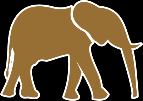

Jul 22 Elephant Tsavo East NP Arrow
Jul 22 Cheetah
Ranch
Causes
Jul 22 Elephant Galana Ranch Snared
Jul 22 Waterbuck Taita Ranches Snared
Jul 22 Elephant Amboseli Environs
Causes
was not feeding, lethargic with saliva
of the mouth Died
wire was strangling this zebra to an extent
had
in breathing and had cut

into
neck tissues Successfully Treated
This zebra was knocked down by a vehicle along the Nairobi Mombasa highway HWC Death
poisoned arrowhead was retrieved from deep, the thigh muscles Poaching Death
revealed an old healing arrow wound of about 6 inches in depth oozing pus
repeatedly for mange resulting in a
body condition
elephant was dragging a winch wire on the right hind limb
had a tight plain wire snare round her neck which caused her discomfort
Treated
Poor
Treated
Treated
He could not lift his head and his abdomen appeared bloated. Postmortem intestinal torsion Died
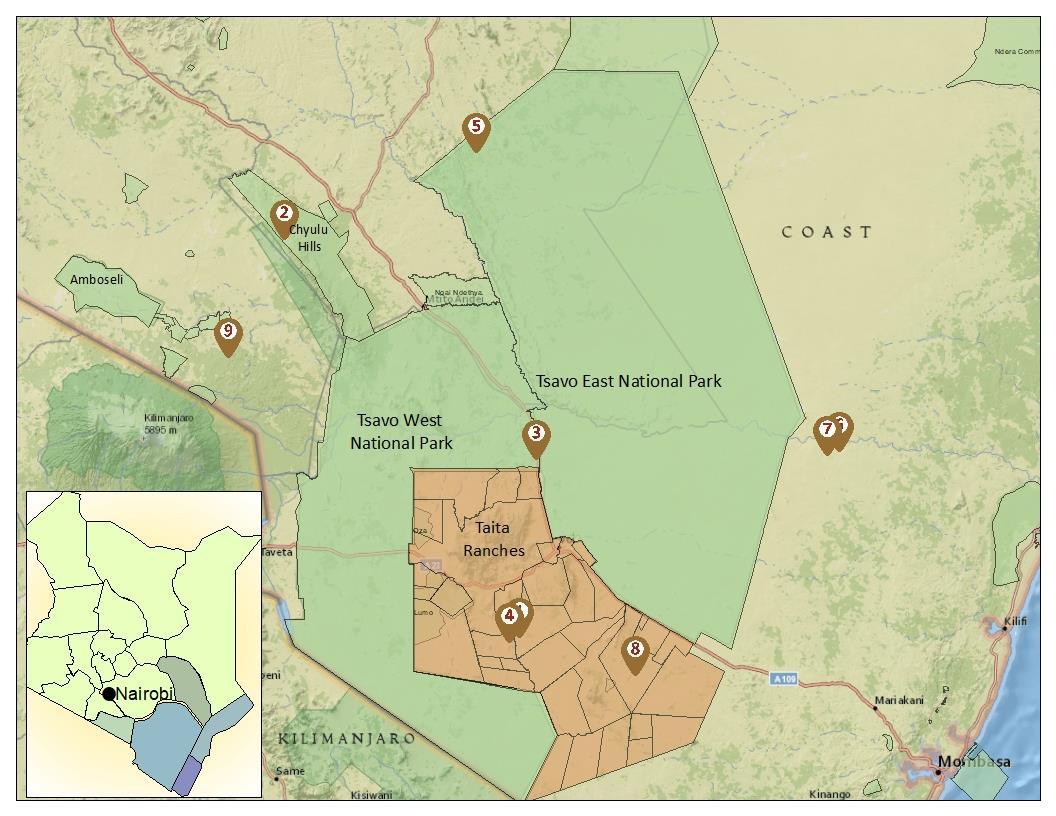
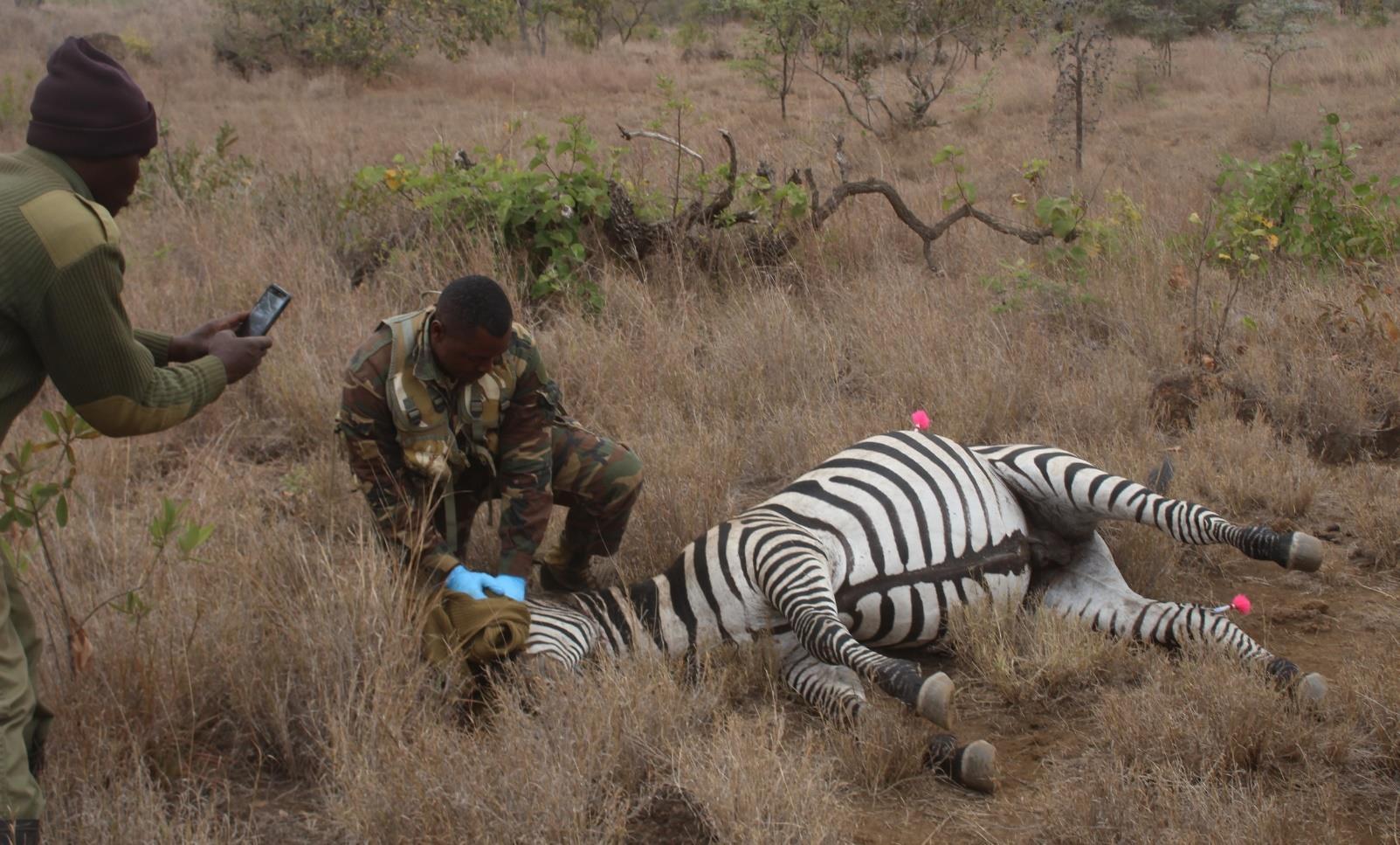
The elephant was observed to be isolated from the rest of herd with poor body condition. He was emaciated, not feeding, lethargic with saliva drooling from the mouth. He also appeared stunted in growth.
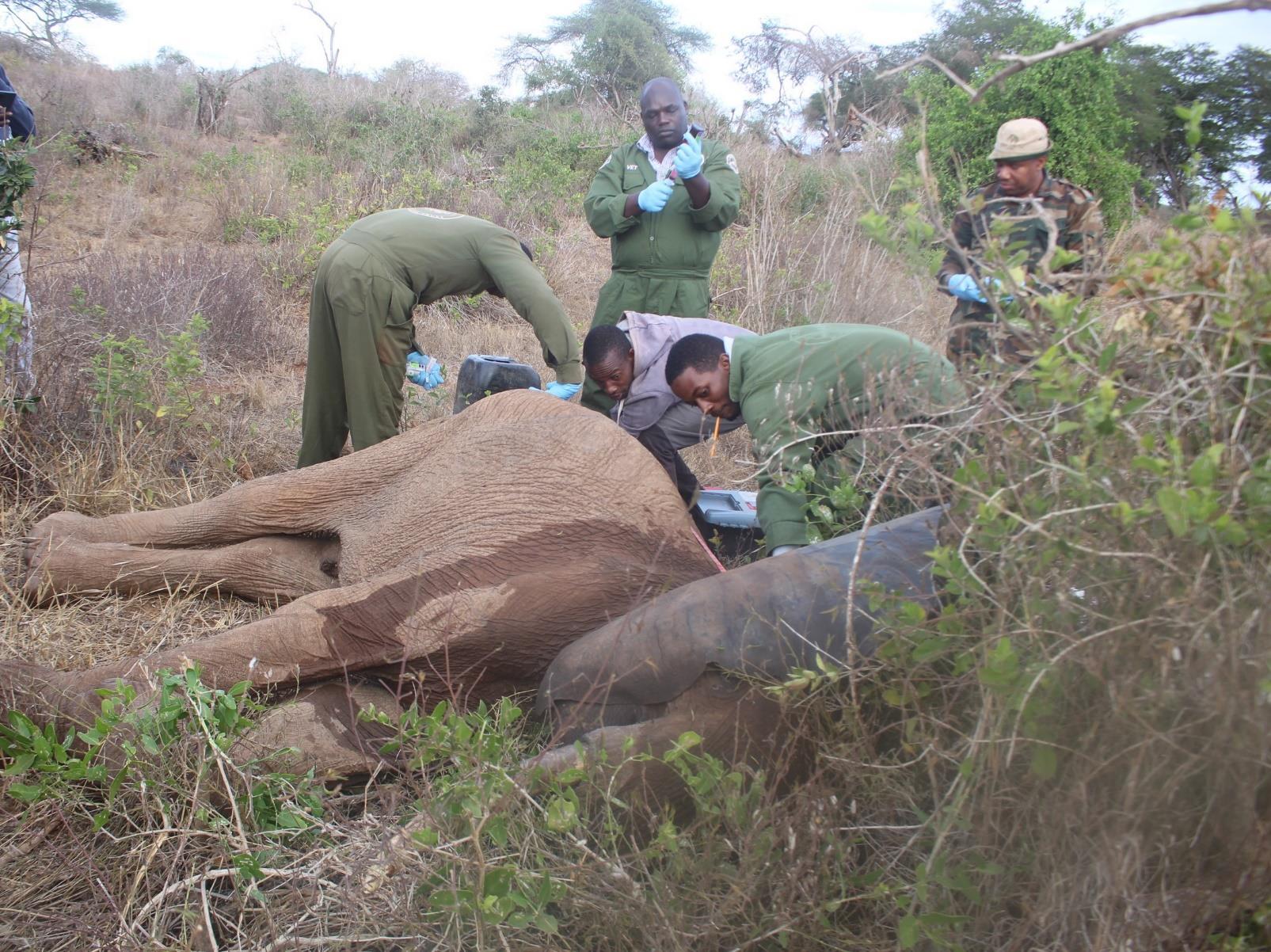
He was immobilized with 5mg Etorphine and the drug took full effect after 5 minutes. Examination revealed extensive yellowing of eye sclera, tongue and oral membranes. Malena and dark tan coloured faecal material with pungent smell was retrieved from the rectum. His tusk size was not proportional to his body size
Injection sites bled easily. He had a seemingly bloated abdomen with signs of ascites. Chronic hepatitis with gastritis was tentatively considered the problem with this elephant. The generalised icterus and bloody faecal material showed that liver functions had been compromised affecting blood clotting abilities. Amoxicillin antibiotics, Vitamin B complex and Dexamethasone anti inflammatory were given.
The anaesthetic was reversed and he got up and retreated into a nearby thicket. Monitoring was advised. Given the nature of the problem with already compromised functions of the liver, his prognosis was considered grave. Sadly, he was found recumbent a week after treatment, in a semi comatose state. To save him from further suffering, euthanasia was recommended and effected immediately.
This zebra was observed to be dragging a winch wire snare from her neck. It had strangled her to an extent she had difficulty in breathing and it had cut deep into the neck tissues. The Big Life Wildlife Team and KWS patrol team reported the case to the Mobile Veterinary Unit.
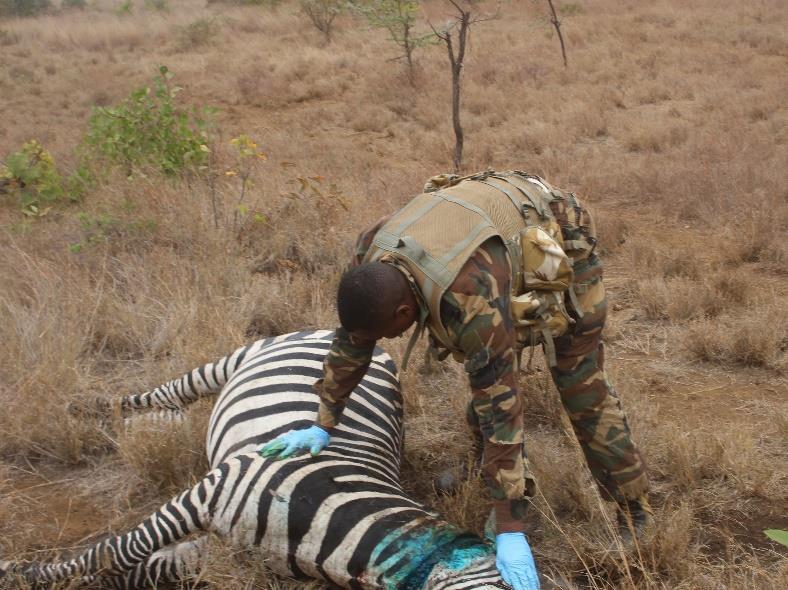
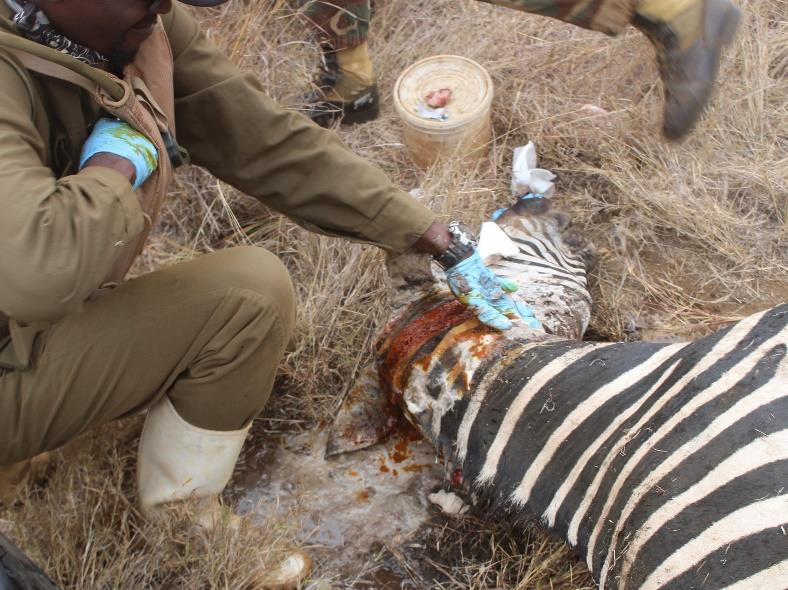
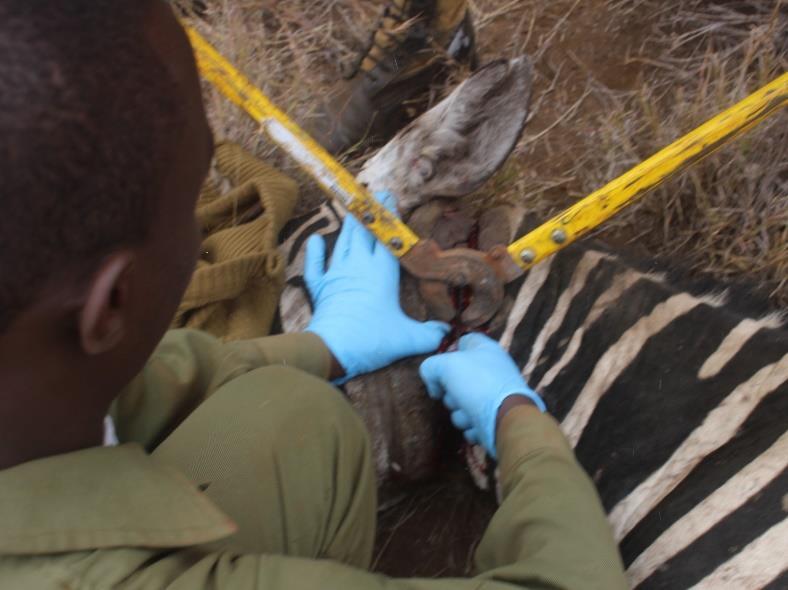
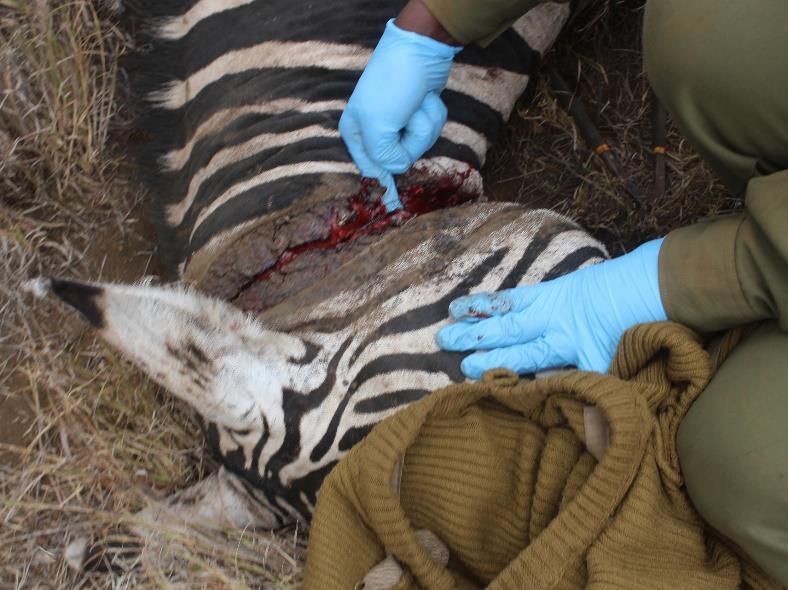
She was chemically retrained using a combination of 7mg Etorphine and 60mg of Azaperone The drug took full effect after 12 minutes.
Examination revealed the wire snare was too tight and had cut deep into the neck muscle tissues and had partially severed the trachea. The wound was cleaned with Hydrogen peroxide, flushed with fresh water and disinfected using tincture of Iodine. Amoxicillin antibiotics and Flunixin meglumine anti inflammatories were administered accordingly.
She could breathe easily with the wire removed though part of the exhaled air went through the perforated trachea. Surrounding tissues can regenerate through granulation with the tracheal opening closing substantially or even fully. Prognosis was considered favourable.
This zebra was seen early in the morning of this date to have been knocked down by a fast moving vehicle along the Nairobi Mombasa highway at Manyani area. She had bruises on the head with difficulty in breathing. KWS team notified the Mobile Veterinary Unit who responded.
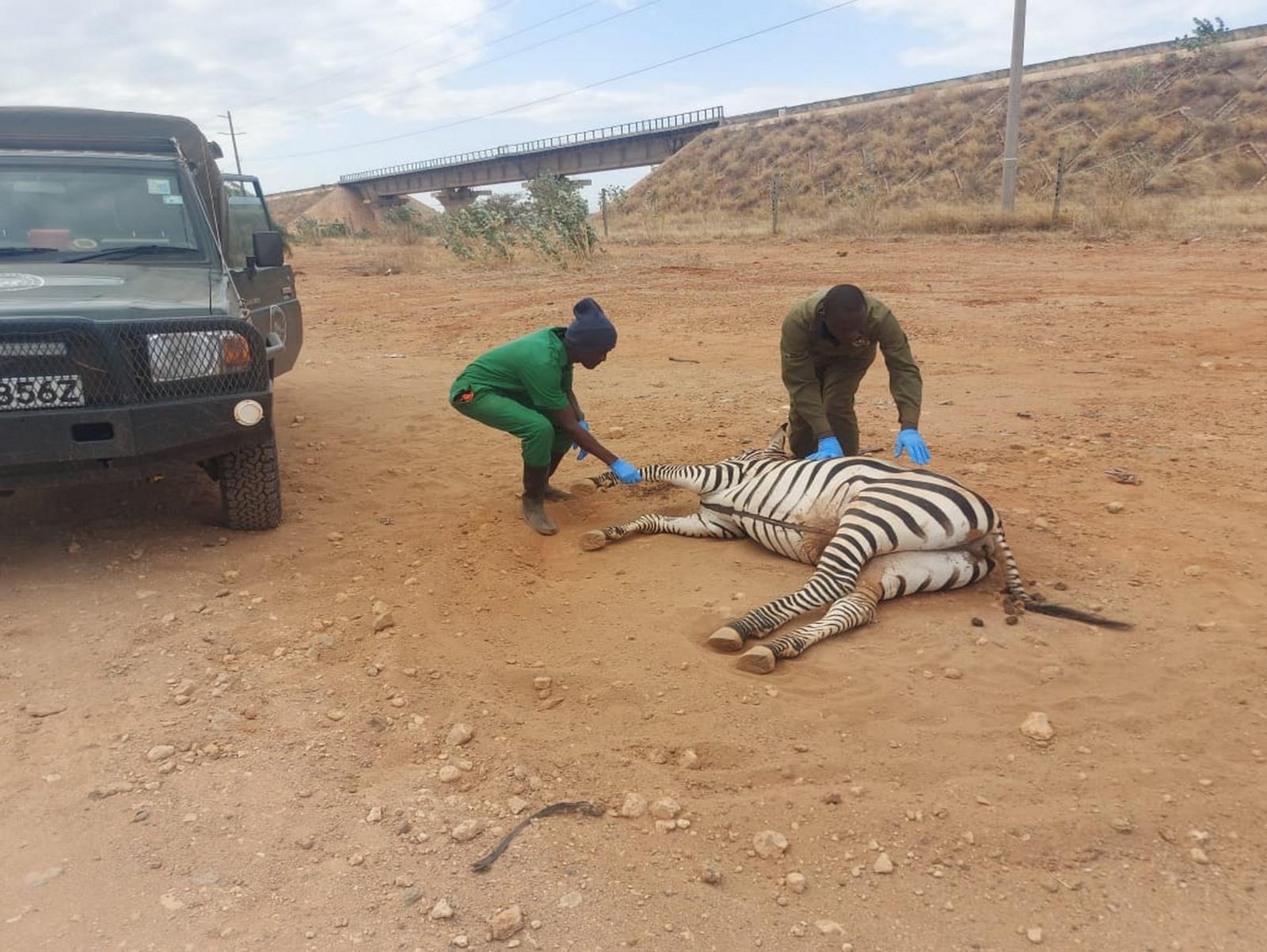
The zebra appeared to have been in severe pain, she had blood stains on the head. She was recumbent and motionless with difficulty in breathing.
She was chemically restrained using 40mg of Medetomidine given intravenously through the jugular vein and was calm after 3 minutes.
Examination revealed she had acute internal bleeding as the mucus membranes were extremely pale.
Due to grave prognosis coupled with complicated internal injuries she was euthanized to avoid further pain and suffering; the carcass was then disposed of properly within Tsavo East National park.
This elephant was observed to be struggling to get up early in the morning of this date by the Taita Sisal Ranch Wildlife Team. This mono tusked elephant was found on left lateral recumbency. He was active and alert but had been struggling for a while as clear mucoid discharge seen on the ground.

This elephant was assisted to rise using a rope tied loosely round his tusk and pulled by two vehicles. He was able to rise up and join a group of bulls browsing nearby. A small discharging wound was observed on his left hind limb. He was agitated and the team decided to give him a chance to relax before being attended the next day. This would also give chance for the muscles to recover after prolonged recumbency.
He was seen a few days later and the Mobile Veterinary Team was called to treat. However, by the time the team arrived, he had collapsed. A treatment was conducted while he was lying down but he died despite the efforts. A poisoned arrowhead was retrieved from deep, the thigh muscles.
The elephant was observed by the SWT aerial patrol team to have suspected arrow wound on the left lateral side of his abdomen oozing pus and slightly swollen
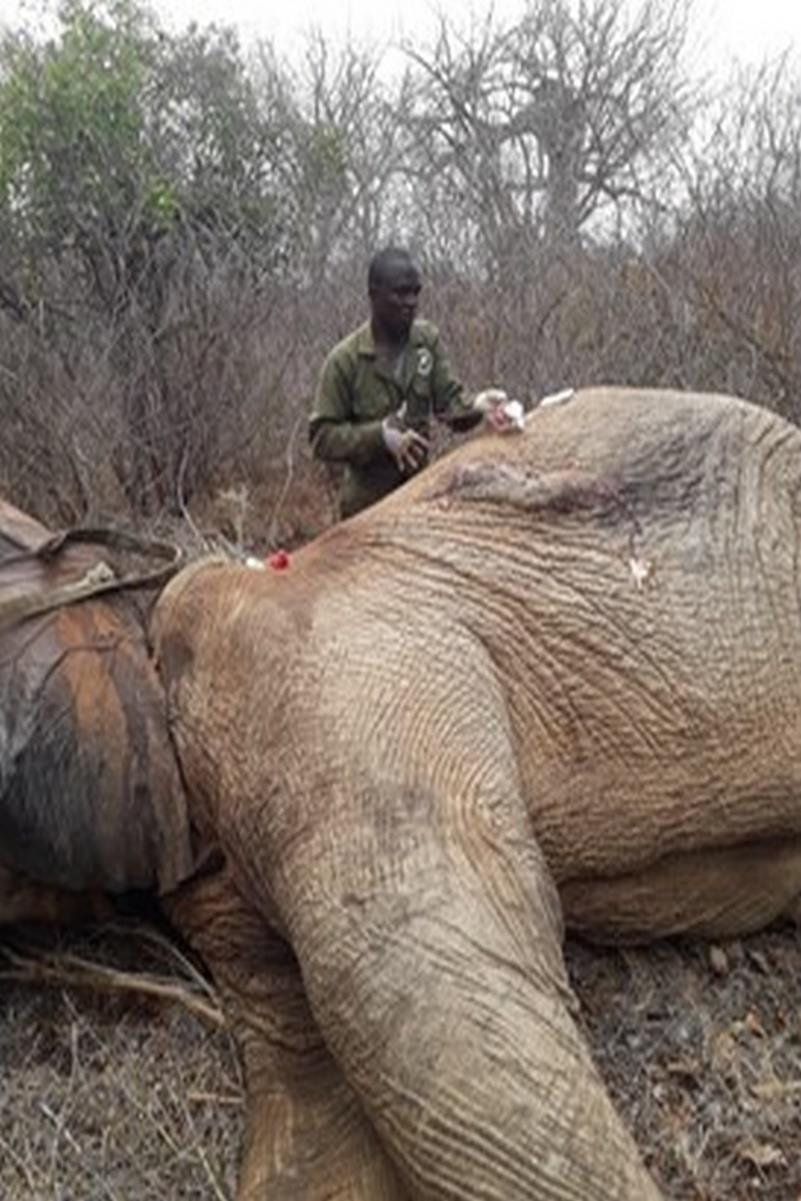
Immobilisation, examination and treatment
The elephant was chemically restrained using 20mg Etorphine hydrochloride from the air. The drug took full effect after 23 minutes.
Examination revealed an old healing arrow wound of about 6 inches in depth oozing pus. The wound was debrided using Hydrogen peroxide and flushed with fresh water. Tincture of Iodine was used for disinfection then natural green clay was packed into the wound. Amoxicillin antibiotics and Flunixin meglumine anti inflammatories were administered appropriately.
He was revived using 36mg Diprenorphine hydrochloride and 50mg Naltrexone and woke up about 2 minutes post revival and walked majestically deep into the bushes. He has a good prognosis.

Two emaciated cheetahs thought to be brothers were observed to be weak and unable to hunt. One of the cheetahs had been treated repeatedly for mange which kept on recurring with deteriorating body condition.
The cheetahs were very emaciated with both having a body condition score estimated to be 1 in a scale of 1 5, with 1 poor and 5 good. They were found lying down in the shade after one of them successfully killed a vervet monkey which they feasted on together. They had unsteady gait while moving with posterior ataxia They had developed severe and chronic mange condition. Due to their poor body condition, they were considered an anaesthetic risk hence they were not immobilized, and Clindamycin antibiotics and Ivermectin drugs were delivered remotely using a 3 ml Dan inject dart. Both the cheetahs were provided with meat as they were too weak to hunt. After treatment they moved to a shade near Galana River. The team on the ground was asked to monitor them and provide more goat meat the next day.
Their prognosis was considered guarded, given the absence of suitable prey in the area at the moment. They also appeared too weak to hunt. They disappeared for the next three days but were found on the fourth day dead. They could have died from severe starvation.
The elephant was observed to be dragging a winch wire on the right hind limb by the SWT patrol teams at Galana Conservancy. The Mobile Veterinary Team was airlifted by the SWT helicopter to attend to the case.
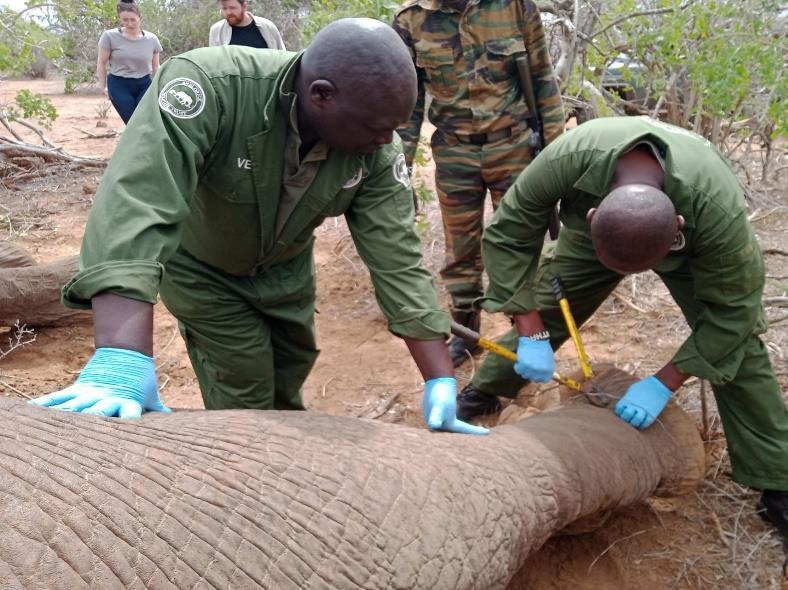
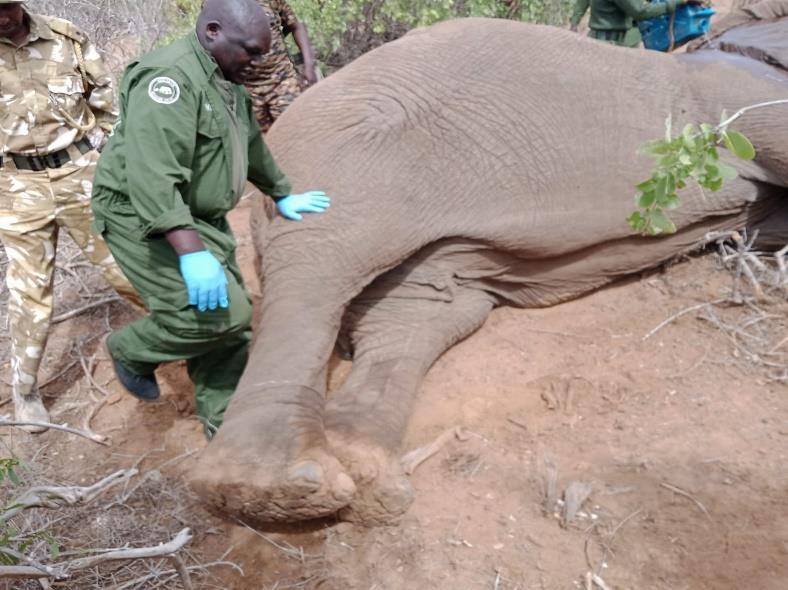
The elephant was found deep within the bushes along Galana River dragging a winch wire tightly attached to his right ankle. The body condition was good. This majestic bull was chemically immobilized using 20mg of etorphine hydrochloride delivered using a 3 ml Dan inject dart from the air. The drug took full effect after 8 minutes with the elephant assuming left lateral recumbency.
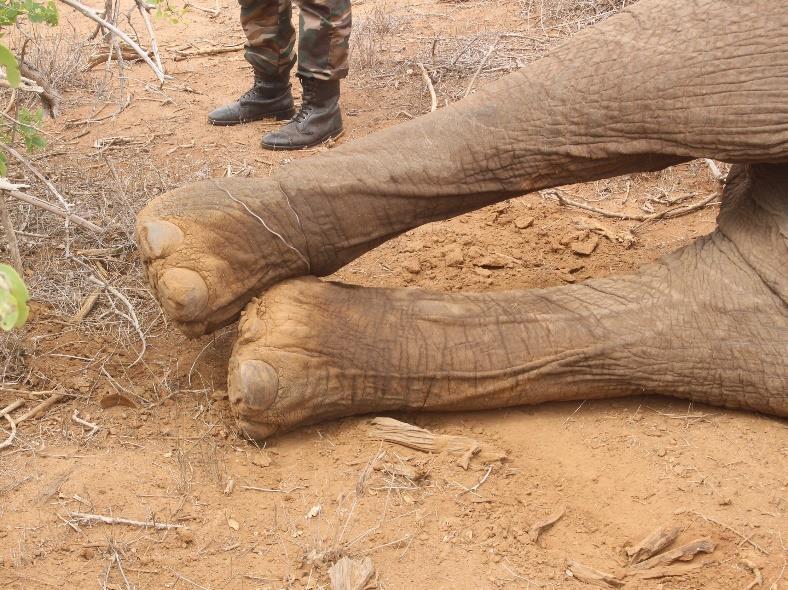
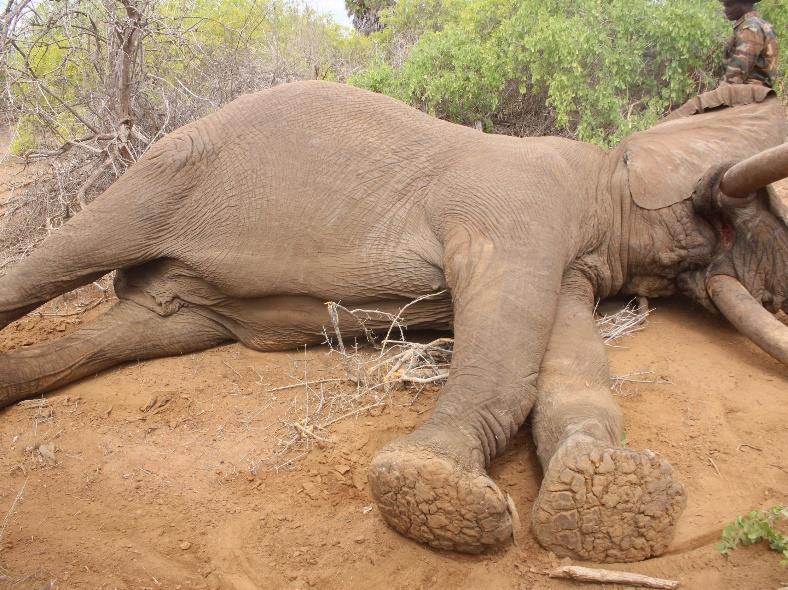
The wire was cut loose and removed, with the resultant wound caused by the snare cleaned and disinfected with tincture of Iodine. The elephant was also given with Amoxicillin antibiotics and Flunixin meglumine anti inflammatories administered parenterally.
He was revived using 60mg of Diprenorphine hydrochloride given through a prominent ear vein and he got up after 2 minutes and walked into a thicket. Prognosis is good.
.
This waterbuck was seen three days earlier by the Wildlife Works Rangers with a wire on her neck, but she was very elusive and mobile. She was then found in a group of four other waterbucks near a watering point. They informed the mobile veterinary team who responded.
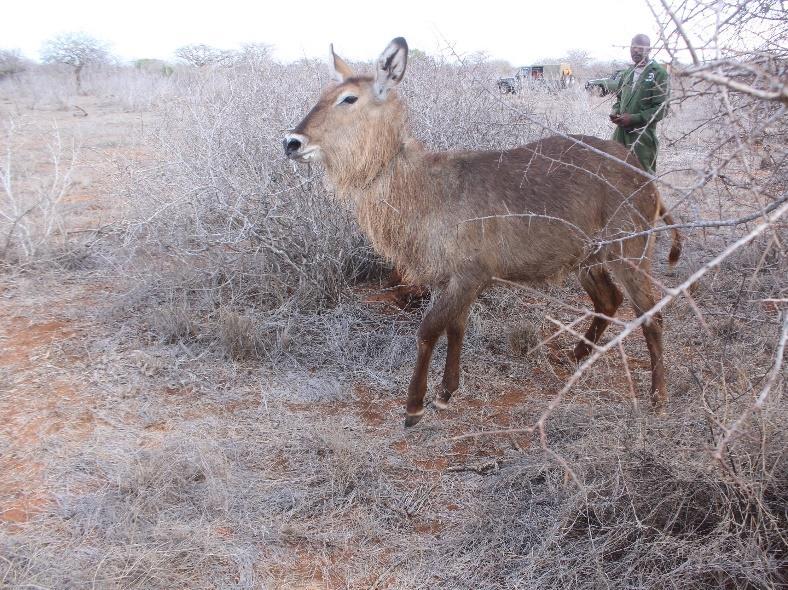
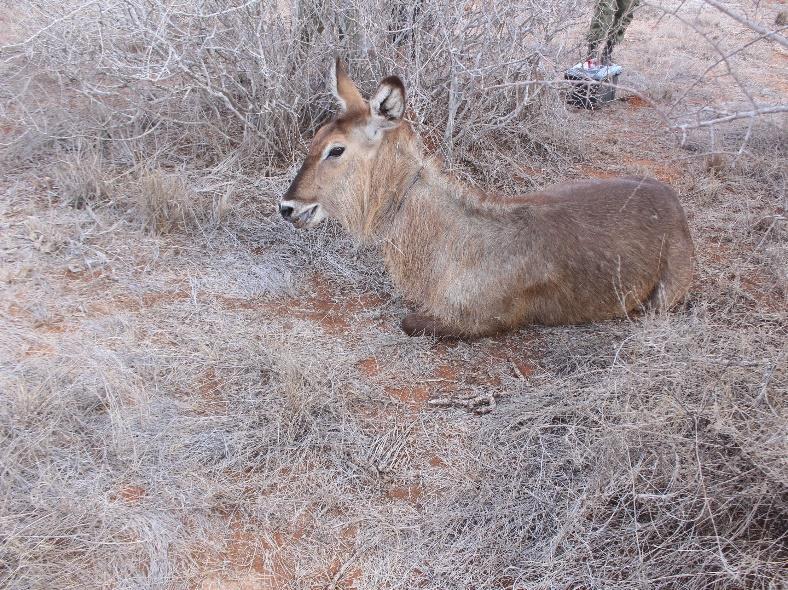
She had a tight plain wire snare round her neck which caused her discomfort.
The waterbuck was chemically immobilized using a combination of 8mg of Etorphine hydrochloride and 60mg Azaperone delivered in a 1.5 ml Dan inject dart. The drugs took full effect after 12 minutes.
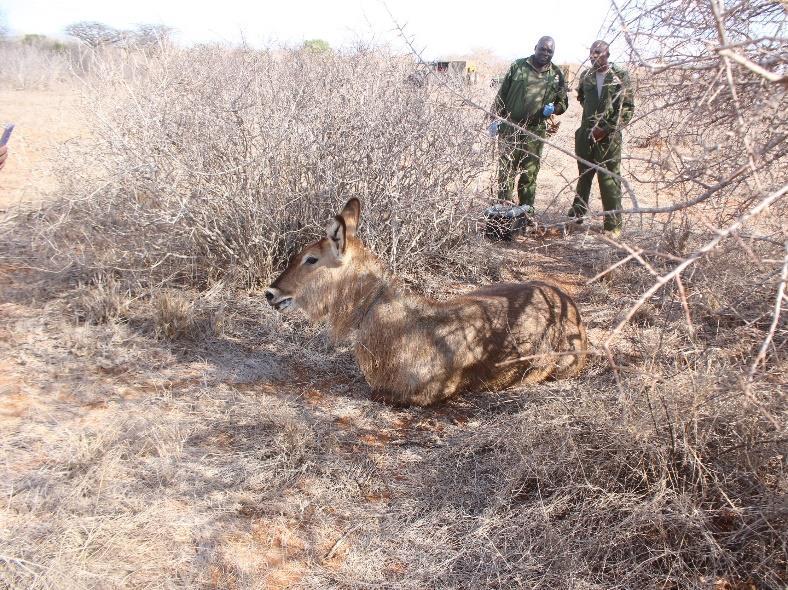
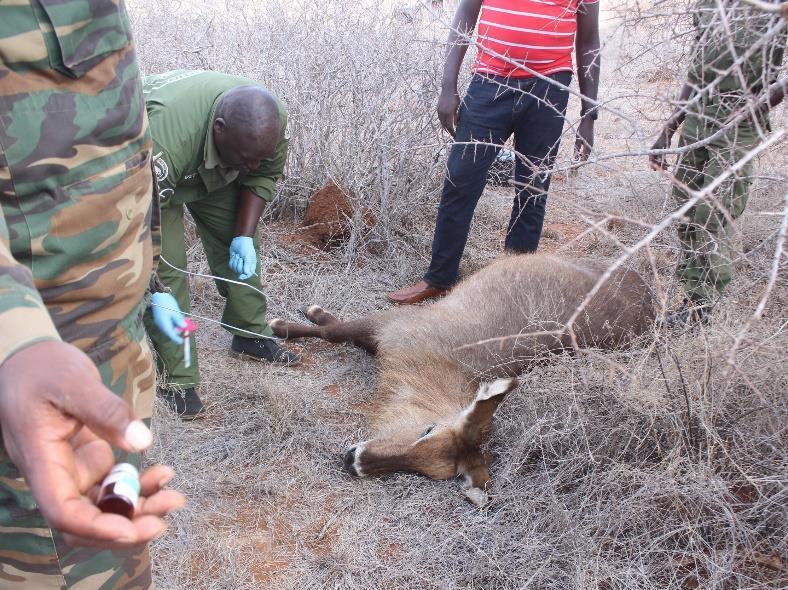
The snare wire was tightly bound to the neck. Fortunately, no serious injuries had been caused by the wire. The wire was cut loose and removed then Amoxicillin antibiotics and Dexamethasone anti inflammatories were administered.
She was revived using 40mg of Naltrexone and 18mg Diprenorphine given intravenously through the jugular vein. She rose up after 2 minutes post revival. Prognosis is good.
This bull was found recumbent by BigLife and KWS rangers on their normal patrols. They notified the mobile veterinary unit for help.
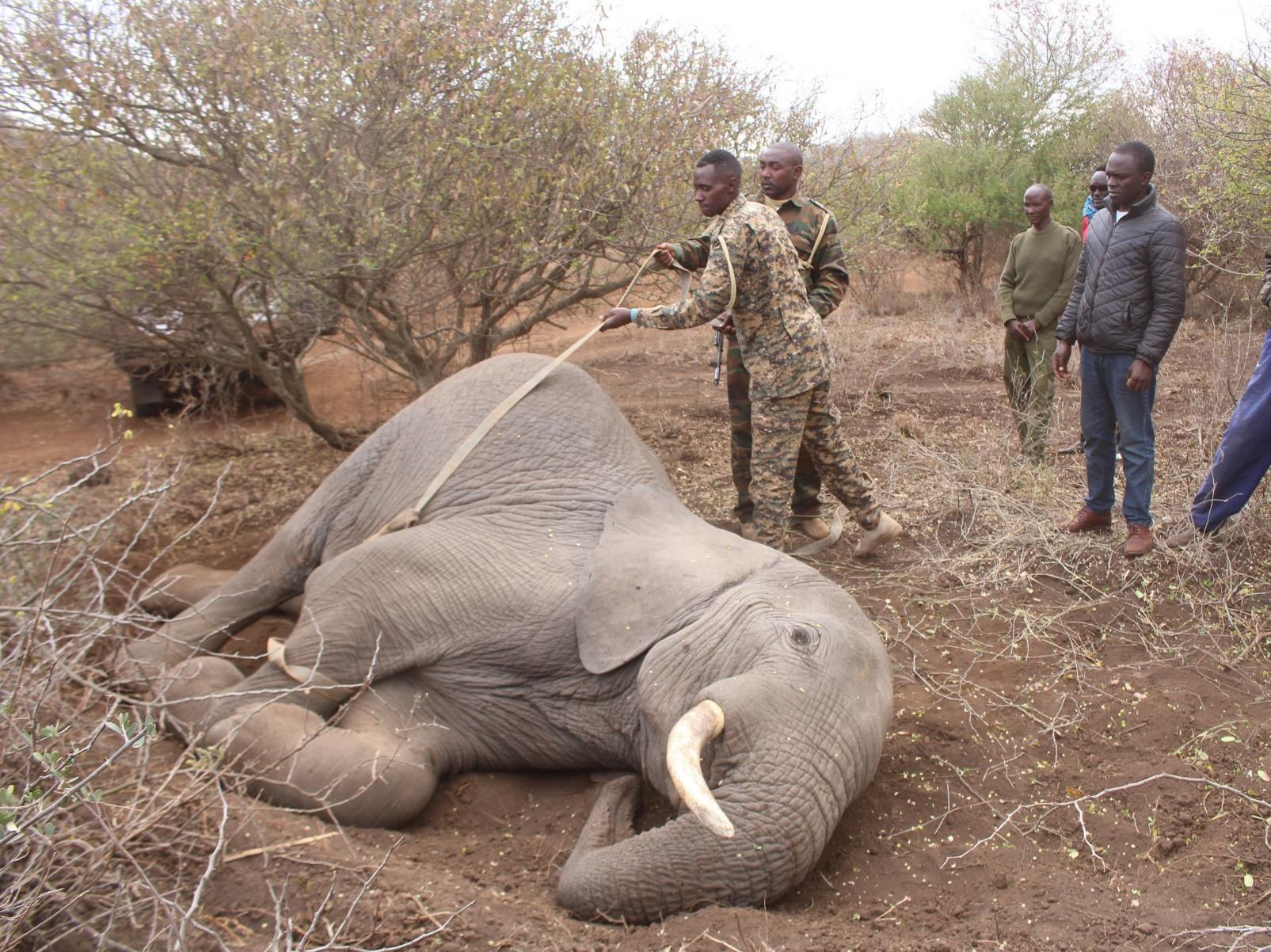
The bull was found lying on his left side with evidence of long struggle. He had been there for about 12 hours unable to help himself up. He appeared exhausted and could not lift his head.
His abdomen appeared bloated. The team tried to help him up several times but were not successful. He was gently turn over and like the like the right side, no injury was detected on the left side. After several minutes of trying to help him, he began to deteriorate further and slipped into semi comatose state.
To stop his further suffering, the team felt it was only reasonable to put him to sleep
A post mortem was carried out immediately after euthanasia and a picture of intestinal torsion was evident with no gastrointestinal contents moving beyond the strangulated part.